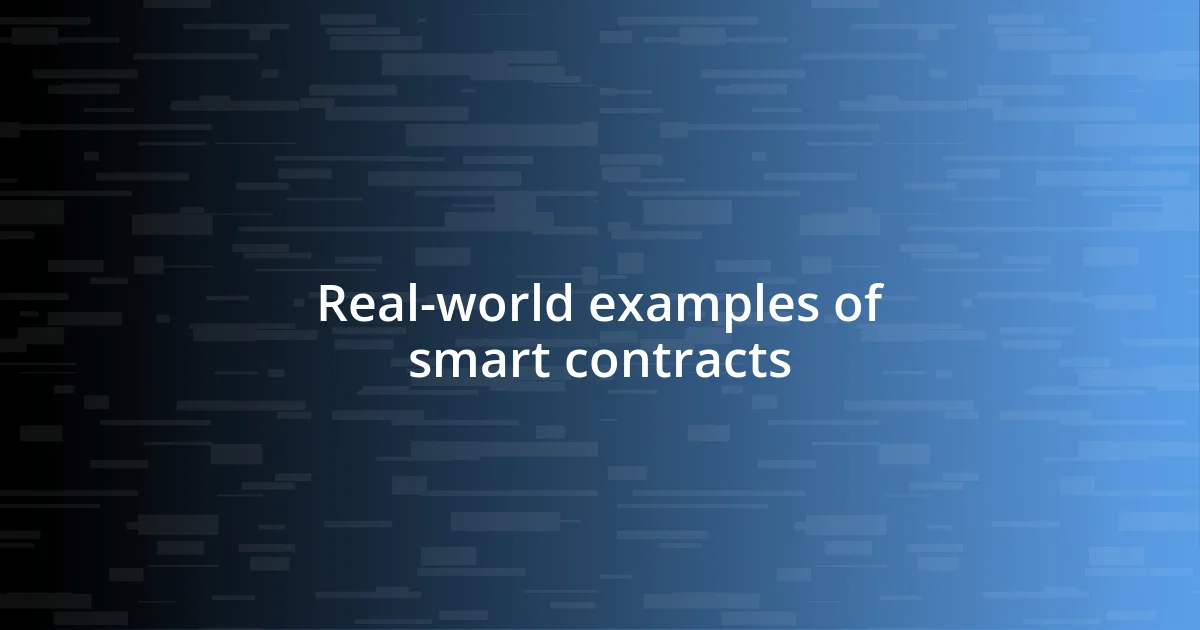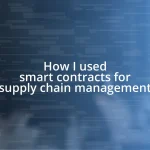Key takeaways:
- Smart contracts automate transactions on blockchain, promoting trust and transparency in various industries, particularly real estate and insurance.
- Key components of smart contracts include code, blockchain, inputs/outputs, and oracles, each crucial for effective execution and reliability.
- Effective teaching strategies for smart contracts emphasize hands-on learning, real-world applications, and collaborative environments to enhance understanding and creativity.

Understanding smart contracts basics
To grasp the basics of smart contracts, it’s essential to recognize their foundation in blockchain technology. Imagine securing a deal without the need for a middleman—sounds liberating, right? That’s the beauty of smart contracts; they execute automatically when predefined conditions are met, ensuring trust and transparency.
When I first delved into smart contracts, I was struck by their potential to revolutionize various industries. For instance, think about real estate. I recall explaining to a friend how a smart contract could automate property transfers, cutting down on time and costs. Can you picture signing a contract, and within minutes, the ownership is officially transferred without any tedious paperwork?
An important aspect to keep in mind is that smart contracts are not inherently “smart.” They operate under the logic programmed into them, which means clarity in coding is paramount. It makes me wonder: how can we ensure that the developers creating these contracts prioritize transparency and security? My experience has shown that having a deep understanding of both the technology and its implications can foster trust in this engaging, yet complex landscape.

Key components of smart contracts
The key components of smart contracts work together to create a robust framework that facilitates trust and reliability. When I first encountered these components, it felt like piecing together a puzzle where each section is vital for the whole picture to emerge. By clearly defining each element, developers can ensure that the contracts are not just automated, but also effective in delivering results that users can genuinely rely on.
Here are the essential components to consider:
- Code: The specific set of rules and conditions that govern the transaction. I often tell my students to think of this as the contract’s DNA—without it, there’s no life.
- Blockchain: The decentralized ledger where the contract resides. It’s like a permanent public record, making the contract verifiable and tamper-proof.
- Inputs: The data needed to trigger the contract’s execution. I remember guiding a group through an exercise where they realized how critical these inputs are in determining contract outcomes.
- Outputs: The results of contract execution, such as asset transfers or notifications. Picture the moment you receive a notification that confirms your property has officially changed hands—it’s incredibly satisfying!
- Oracles: These are third-party services that supply the contract with real-world data needed to execute the contract conditions. Think of oracles as interpreters that help the digital world communicate with reality.
Understanding these components has transformed how I teach others about smart contracts, helping them see the delicate interplay between technology and trust.

Tools for creating smart contracts
When it comes to creating smart contracts, a variety of tools are at our disposal, each with unique features that cater to different needs. For example, I’ve used Ethereum’s Solidity extensively, which feels like a natural choice for developers familiar with JavaScript. It’s impressive how this language, tailored for Ethereum, allows for complex contract creation. However, I’ve also experimented with Hyperledger Fabric, particularly appealing for enterprise applications due to its modular architecture. The first time I helped a small business implement a supply chain solution using Hyperledger, I was amazed by how it simplified transactional transparency.
Moreover, more user-friendly platforms like OpenZeppelin and Truffle have become go-to resources for many. I remember guiding a class of budding developers through the Truffle Suite, and their excitement over quickly deploying contracts was contagious. The combination of testing, migration, and local blockchain allows budding developers to learn without the pressure of making mistakes on live networks, fostering a safer learning environment.
To make an informed choice about which tool to use, it’s crucial to consider factors like ease of use, community support, and whether the tool aligns with your specific project’s requirements.
| Tool | Key Features |
|---|---|
| Solidity | Primary language for Ethereum smart contracts, resembles JavaScript, supports complex contract creation. |
| Hyperledger Fabric | Modular architecture for enterprise use, focuses on privacy, flexibility, and scalability. |
| OpenZeppelin | Provides reusable smart contract templates, emphasizes security audits for contracts. |
| Truffle Suite | A comprehensive suite for smart contract development, includes testing, deployment, and local blockchain creation. |

Teaching strategies for smart contracts
One effective strategy I employ when teaching about smart contracts is to encourage hands-on learning. I remember a workshop where I had participants build their own basic smart contracts from scratch. It was fascinating to watch their faces light up as they successfully executed a contract for the first time. That sense of accomplishment inspires deeper engagement and understanding. Have you ever experienced that “a-ha” moment when everything clicks? Those moments can really amplify a learner’s curiosity and willingness to explore.
Another approach I find impactful is integrating real-world scenarios into lessons. For instance, I often use examples from the supply chain sector, demonstrating how smart contracts can streamline processes and reduce fraud. Sharing a case study about a company that used smart contracts to track product authenticity generated quite a buzz in one of my classes. Students began to see not just the technology but the significant impact it could have on businesses—they could relate to it and envision its practical applications.
Finally, fostering a collaborative environment can significantly enhance the learning experience. I’ve implemented group projects that encourage students to brainstorm innovative uses for smart contracts. This not only nurtures teamwork but also stimulates creative thinking. One memorable session involved teams pitching ideas for community-focused applications, and I was blown away by their fresh perspectives. Isn’t it incredible when learners surprise you with their creativity? It reminds me why I love teaching this subject—it’s not just about the technology, but the possibilities it unlocks.

Real-world examples of smart contracts
One of the most telling examples of smart contracts in action is in the insurance industry, particularly health insurance. I recall a project where we designed a smart contract for automated claims processing. The moment we witnessed the system approving and paying out claims without human intervention was truly eye-opening. Have you ever thought about how such technology could reduce fraud and improve efficiency in an industry that’s often bogged down by paperwork?
In real estate, I once engaged with a startup that aimed to streamline property transactions through smart contracts. They implemented a system where ownership transfers were automated and secured on the blockchain, allowing for a more transparent process. I still vividly remember the excitement in the room during a demo when we saw a house deed change hands instantly – it felt like we were stepping directly into the future of buying and selling property. Can you imagine the stress and confusion this could alleviate for both buyers and sellers?
Additionally, I had the opportunity to explore how smart contracts can enhance supply chain management. In a recent case, a retailer used smart contracts to track the journey of products from suppliers to store shelves. What struck me was the enthusiasm of the operations team when they discovered they could verify authenticity at every stage seamlessly. Isn’t it inspiring to think about how technology can not only improve business processes but also bolster trust in consumer relations?

Overcoming common challenges in teaching
I often encounter challenges when students struggle with the technical jargon associated with smart contracts. The first time I introduced terms like “immutable” and “decentralized,” I could see some faces glazed over. To overcome this, I focus on breaking down complex concepts into simpler language, often using analogies. For example, I compare smart contracts to vending machines—if you put in the right input, you get the correct output. This not only clarifies the terminology but also helps students visualize how smart contracts operate.
Another common challenge is addressing varying levels of prior knowledge. I once taught a group that included seasoned developers alongside complete beginners. At first, I worried about losing the interest of the more advanced learners while not overwhelming the novices. To tackle this, I balanced the content by providing foundational resources and then layering in advanced concepts as I sensed the group’s comfort with the material. Have you ever found that sweet spot where everyone feels challenged but not lost? It’s rewarding to see learners of different backgrounds connect and share insights during discussions.
Finally, it’s essential to keep the learning environment engaging, especially when discussing more abstract ideas. I remember a session where I used gamification to illustrate how smart contracts could function in various scenarios. We simulated a marketplace where teams had to negotiate and execute contracts to complete tasks. As laughter filled the room amid friendly competition, I realized that play can transform understanding. It makes me wonder—how often do we overlook the power of fun in education? Embracing that element can turn challenges into opportunities for deeper learning.














